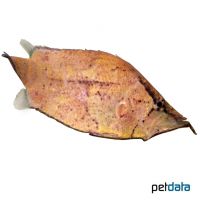Amazon Leaffish (Monocirrhus polyacanthus)
| Amazon Leaffish Monocirrhus polyacanthus | |
|---|---|
| Name | Amazon Leaffish |
| Name Lat. | Monocirrhus polyacanthus |
| Family | Leaffishes |
| Family lat. | Polycentridae |
| Order | Ovalentarias |
| Order lat. | Ovalentaria inc. sed. |
| Origin | South America |
| Habitat | Rivers, oxbow lakes |
| Diet | Carnivore |
| pH | 5.0-7.0 |
| Behavior | Predatory |
| Keeping | Pair, group |
| Care Level | Experts only |
| Reproduction | Substrate spawner |
| Breeding | Difficult |
| Life Span | 5-8 years |
| Protection | No |
| Metric Units | |
| Size | 10 cm |
| Temperature | 24-28 °C |
| Hardness | 2-10 °dH |
| Aquarium | 100 l |
| US Units | |
| Size | 4" |
| Temperature | 75-82 °F |
| Hardness | 36-178 ppm |
| Aquarium | 25 gal |
Distribution and habitat
The range of the Amazon Leaffish is Brazil, Peru, Venezuela, Colombia and Bolivia. They live in slow-flowing to stagnant waters, with dense underwater vegetation and fallen leaves, where they like to stay, well camouflaged, mostly near the shore between plants and branches protruding into the water.
Maintenance
They need an aquarium with dense planting, branches and roots that provide numerous hiding places, as well as sufficient swimming space. A dark sandy substrate covered with some foliage (e.g. sea almond tree, beech, oak leaves etc.), subdued light (floating plant cover), clear, soft, slightly acidic water and a very weak current is ideal.
No ammonia, ammonium and nitrite should be detectable, the nitrate value should not exceed 100 mg/l. To ensure the water quality and oxygen content, a filter and heater adapted to the aquarium size is required, as well as lighting for the species-appropriate day-night rhythm of the animals.
Diet
They are predatory lurkers. The food supply consists of live fish, such as neons and guppies. A leaf fish will eat one to two fish per day. Frozen food as well as flake or granulated food is not accepted
Regular feeding promotes health and increases resistance.
Behaviour and compatibility
These shy, hidden animals should be kept in pairs or in a group. To avoid turf wars, one group should be introduced into the aquarium at a time. Group keeping is only recommended in a larger, richly structured tank. They can be kept with other calm fish, such as larger tetras and catfish. However, keeping them in a species tank is recommended. Fish that are too small are considered food. Basically, only compatible fish species with similar demands on water condition and water temperature should be socialized.
Sex dimorphism
The sexes are very difficult to distinguish. The females usually appear a little rounder due to their eggs located in the abdomen.
Reproduction and breeding
There are isolated reports of successful breeding in the aquarium. They spawn on plants, stones or roots and the male guards the clutch. The young hatch after about 4 days and swim free after a few days.
Fry must be fed several times a day with special rearing food (Artemia nauplii). Breeding is hardly possible in a community tank, as the fry are easy prey.
Important
The Amazon leaffish often stands motionless, head down in the water at an angle, with no fin movement visible, and lurks for prey fish, which it sucks in with its wide protruding mouth. Its body structure resembles that of a leaf and instead of a dorsal fin, it has only spiny fin tips. It can change both coloration and markings to appear yellow, brown or black, spotted or striped, perfectly camouflaged to blend into its environment, invisible to other fish.
They are very sensitive to deterioration of water quality.
The well-being of the fish should be monitored regularly. Temperature should be checked daily, pH, hardness and nitrate levels at least fortnightly. Regular partial water changes are recommended, even if the contaminant level has not yet reached the upper limit. Sudden changes in water quality should be avoided. Newly introduced fish must be accustomed slowly to the water in the aquarium.
Further literature can be found in your pet store.
References
Text: Werner Winter; Image: petdata
Source: BMELV (1998): Tierschutzgutachten - Haltung von Zierfischen (Süßwasser); RIEHL & BAENSCH (2006): Aquarien Atlas Bd. 1, Mergus Verlag; ENGELMANN (2005): Zootierhaltung - Tiere in menschlicher Obhut: Fische, Verlag Harri Deutsch
- Gemäß § 21 Abs. 5 Tierschutzgesetz idgF
